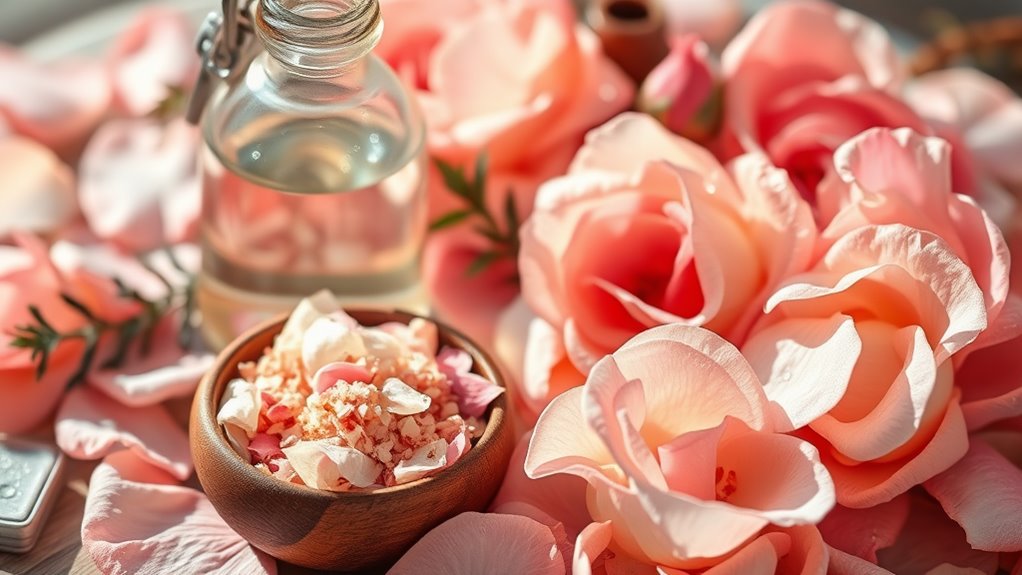Why Everyone’s Talking About DIY Rose Oil Lately
Did you know that DIY rose oil can be traced back to ancient civilizations, where it was revered for its healing properties? Today, it’s gaining traction among those seeking natural skincare alternatives. With its myriad of benefits, from hydration to stress relief, it’s no wonder people are eager to craft their own. But what makes this rose-infused oil so special, and how can you easily create your own at home? Let’s explore the allure of DIY rose oil.
Key Takeaways
- DIY rose oil hydrates the skin, reduces fine lines, and provides a calming scent, making it a popular beauty choice.
- The rise in natural beauty products has increased interest in DIY rose oil for its gentler ingredients and lower environmental impact.
- Customizable recipes for making rose oil allow individuals to tailor the oil to their personal skincare needs and preferences.
- Freshly harvested roses, especially Rosa damascena, yield high-quality oil, contributing to the appeal of DIY rose oil.
- The growing awareness of the benefits of natural ingredients has sparked conversations about DIY rose oil’s effectiveness in skincare routines.
The Benefits of DIY Rose Oil
DIY rose oil offers a multitude of benefits that can enhance both your beauty routine and overall well-being.
This fragrant elixir hydrates your skin, making it feel soft and supple while reducing the appearance of fine lines.
You’ll love how its calming scent can uplift your mood and alleviate stress, turning your self-care moments into a serene escape.
Additionally, DIY rose oil can help balance oily skin and soothe irritation, promoting a clearer complexion.
Incorporating this versatile oil into your daily regimen not only enhances your beauty but also nurtures your spirit, making it a must-try for anyone seeking natural solutions. Moreover, the process of creating your own oil can be incredibly rewarding and allows you to customize the blend to suit your individual needs and preferences, making it a true DIY experience.
Simple Recipes for Making Rose Oil at Home
Have you ever wondered how to capture the enchanting scent and benefits of roses in your very own home? Making rose oil is simpler than you think! Here’s a quick guide to get you started:
| Method | Ingredients |
|---|---|
| Infusion | Fresh rose petals, carrier oil (e.g., olive, jojoba) |
| Distillation | Fresh rose petals, water |
| Cold Press | Dried rose petals, essential oil (optional) |
Choose a method that suits you, follow the steps, and soon you’ll have your very own homemade rose oil. Enjoy the delightful aroma and skincare benefits! Additionally, just like calendula oil, rose oil can provide skincare benefits that nourish and rejuvenate the skin.
The Rise of Natural Beauty Products
In recent years, the demand for natural beauty products has skyrocketed, reflecting a growing awareness of the benefits of using ingredients derived from nature.
You’re likely drawn to these products for several reasons:
- Skin-friendly: Natural ingredients are often gentler on your skin.
- Eco-conscious: They typically have a lower environmental impact.
- Healthier alternatives: Many avoid harmful chemicals found in conventional products.
- Unique scents and textures: Natural ingredients provide diverse and pleasant sensory experiences.
As you explore the world of DIY beauty, embracing natural products like rose oil can elevate your routine and connect you to nature’s nourishing essence. Additionally, using herbal-infused oils can enhance your skin’s health by providing nourishing properties that promote a radiant complexion.
How to Choose the Right Roses for Oil Extraction
When it comes to extracting rose oil, choosing the right rose variety is crucial for achieving the best fragrance.
You’ll want to consider the ideal harvesting time, as this can greatly impact the oil’s quality and aroma. Additionally, selecting roses with high essential oil content can significantly enhance the richness of the extracted oil.
Best Rose Varieties
Choosing the right rose varieties for oil extraction is crucial for achieving the best aromatic results.
The fragrance and oil yield can vary significantly, so consider these top contenders:
- Rosa damascena: Known for its rich, sweet scent and high oil content.
- Rosa centifolia: Also called cabbage rose, it offers a complex fragrance ideal for perfumery.
- Rosa gallica: Offers a strong aroma and is traditionally used for essential oil production.
- Rosa rugosa: Highly resilient and produces a lovely, fruity scent.
Select wisely, and you’ll create a beautiful, fragrant oil that captures the essence of these stunning blooms.
Harvesting Time Considerations
Timing plays a pivotal role in harvesting roses for oil extraction, and understanding the right moment can significantly impact the quality of your oil.
Ideally, you should pick roses early in the morning when dew still clings to the petals, ensuring maximum freshness.
Look for fully opened blooms, which contain the highest concentration of essential oils.
Avoid flowers that are wilting or showing signs of damage.
Be mindful of the season; late spring to early summer is prime time for aromatic varieties.
Aroma and Fragrance Quality
The essence of a rose isn’t just in its beauty; it’s in its captivating aroma, which is crucial for oil extraction.
To select the perfect roses for your DIY oil, keep these tips in mind:
- Choose fragrant varieties like Damask or Bourbon roses.
- Harvest in the morning when the scent is most potent.
- Look for fully bloomed flowers; their aroma is at its peak.
- Avoid any damaged or wilted petals to ensure quality.
Tips for Storing and Using Your DIY Rose Oil
While you may be excited to use your DIY rose oil, knowing how to store and apply it effectively can enhance its benefits and longevity. Here are some tips:
| Storage Method | Usage Tips | Shelf Life |
|---|---|---|
| Dark glass bottles | Dilute with carrier oil | 6 months to 1 year |
| Cool, dry place | Use in skin care routine | Check for scent change |
| Avoid sunlight | Add to baths | Discard if cloudy |
| Label and date | Use in aromatherapy | Store away from heat |
Proper storage and application will ensure your rose oil remains a fragrant treasure. Additionally, you can enjoy its calming effects, similar to those of lavender oil, when used in your relaxation routines. Enjoy!
Community and Online Resources for DIY Enthusiasts
As you enjoy the fruits of your DIY rose oil project, connecting with fellow enthusiasts can enhance your experience and knowledge. Online communities offer a wealth of resources to inspire your next creation. Here are some great places to explore:
- Social Media Groups: Join Facebook or Instagram groups dedicated to DIY projects.
- YouTube Channels: Discover tutorials and tips from experienced DIYers.
- DIY Blogs: Read articles and guides that delve into techniques and ideas.
- Online Forums: Engage in discussions, share your experiences, and ask for advice.
Incorporating essential oils into your DIY projects can significantly transform your home’s atmosphere. With these resources, you’ll not only enhance your skills but also build lasting friendships in the DIY community!

